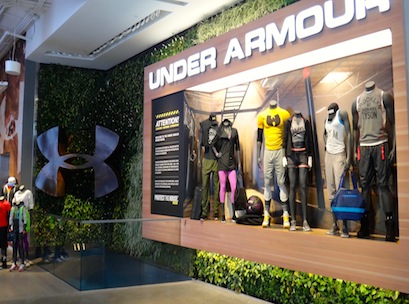This is the story of Kevin Plank, who went from a dusty basement in to Broadway in SoHo, New York in 18 years. It’s the tale of the then 23 year old who started a business in his grandmother’s row house in Washington D.C. and finished up with a ‘brand house’ in New York City. It’s the fable of Under Armour, the sports and lifestyle brand that set out to rid the world of sweat soaked t-shirts and replace them with moisture wicking microfibre. Last week I visited the brand new Und
er Armour Brand House (the fifth in the US), smack bang in prime position on Broadway, and in many ways it is the American dream brought to life in bricks, mortar, pixels, and plants.
Pixels and plants? Well, the first thing to hit you as you walk in the door is a massive, high definition jumbotron (their words) screen, serving up large, luscious images of Under Armour products and athletes.
It’s Under Armour in XXXXXXXXXXXL and it’s visually stunning. The second impact point is a living wall with 2500 plants, symbolising a living, changing, growing brand.
Beyond the impressive entry, Under Armour gets down to the serious business of selling product (as equally American as the rags to riches creation myth itself).
If the old adage of stock sells stock is true, the store has a ton of it. (And a capacious back of house too: the brand house also services online sales.) The sales goal is four items per customer; in other words a complete outfit – top, bottom, accessory, and footwear.
There’s some slightly less expected product as well, such as TRX fitness systems and downloadable apps.
Besides the product, there is plenty to reinforce brand values and retain shopper interest. Each of the changerooms is themed as a different Under Armour brand house location (New York, Baltimore, London, and so on), cleverly lined with mirrors to reflect each cityscape and make the rooms feel huge.
Under Armour water is complimentary, because it likes to provide “amenities for athletes”.
Outside of the changerooms is a chalkboard hero wall, designed to be filled over time with signatures and quotes from visiting Under Armour athletes.
On the lower level, tucked away under the stairs is the re-creation of the row house basement where the Under Armour story began – except it’s been cleaned up and Disney-fied.
It’s now a nice little nook for VIPs and heavy spenders to indulge in personal shopping, while they sit back, enjoy a drink and the TV, and wait for apparel and shoes to be brought to them.
This store is not necessarily going to change the course of retail. Nike has been executing flagship stores and story telling brilliantly for a very long time. I’ve seen massive screens at Burberry in Regent St London, and green living walls at Anthropologie on the same strip.
But I did like the way that the Under Armour brand house aimed to methodically tell its story and develop its own language – for example, the store associates are called team mates and customers athletes.
I was also charmed by the row house under the stairs for shoppers to discover. And the store must have done its job, because I wanted to buy the product.
P.S. The American dream, including Under Armour, is told in a Y&R ad for Dell.
Jon Bird is MD, global of Labstore, Y&R’s worldwide retail and shopper marketing network. Email: jon.bird@yrlabstore.com. Twitter: @thetweetailer. Blog: www.newretailblog.com.
This story first appeared in Inside Retail PREMIUM, issue 1999.

